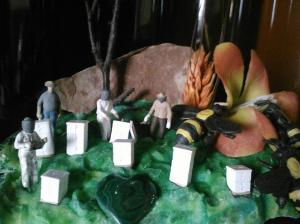I receive many bee-themed gifts, all of which are delightful. One of my favourites were these model railroad layout beekeepers my older sister gave me. I had a sudden urge to do something with them one night and switched off the TV/internet and put a vinyl on the turntable. I went to the kitchen and made some good old fashioned play dough from flour, salt, a little bit of oil, and water. While the dough was still wet, I coloured it in with a couple different shades of green markers, and stuck in the beekeepers and a bunch of other stuff from around my house. I like how the bees are bigger in proportion to the beekeepers, because they really, truly are.
Category Archives: Pleasure
Fun, bee-related stuff
Bee Whispering
Once you get to know honey bees as I have, you’ll find an extra-special spot for them deep in your psyche. Interest and passion for honey bees likely comes from the primitive vestiges of our heart-brain, where a human knows that making friends with this insect actually ensures survival. The honey bee can provide a human with surplus honey that serves as both food and medication, beeswax for light and fuel, and highly proteinaceous larvae and pollen for eating (which I have tried – not bad!).
I fell under their spell many years ago, and make a point of always having a hive or two (or 30) of my own. There is something highly rewarding about good beekeeping, but the feelings are hard to narrow down into a few words. One of the recurring feelings I get is that of acceptance…that the bees are accepting me; I am not an intruder, but an admiring servant. Another feeling is that if you learn how to listen to the bees, you will be able to hear when they are sick, angry, happy, or in need of a new queen. Sounds crazy! I guess it kinda is…especially considering that any of this needs to be experienced first hand, as opposed to being written about.
On a sunny day in March of last winter, I went and checked up on them. I have this ritualistic thing that I do when it’s relatively warm out and the bees start flying around…and this time I filmed it.
Bee-52 Fail
Pondering Pollination
I’m not an advocate for just one kind of bee or animal. I speak loudly when it comes to protecting all species of pollinators, their habitat, and the flowers that bear the fruit and vegetables WE ALL need to live.
In short, anything that flowers will have a pollinator to appease. Why else would a plant invest so much energy into forming a flower and making nectar (which is costly for a plant) if it weren’t to attract a pollinator? The plant does this because it needs to have SEX, and considers a honey bee to be its little hairy cupid, seeing how it can’t get up and take another flower out on a date. The act of pollination is to pass along pollen (plant-sperm) from one flower’s stamen (penis) to another flower’s stigma (vagina). The pollen germinates down the flower’s style (uterus) where the ovaries are located. This act of actual fertilization results in an embryo, or a baby, which is the fruit or vegetable that contains the SEED for the next generation. full pollination description here
Drawn in by colours (even ultraviolet), odours, and the nectar reward, a bee lands on a flower to feed on the nectar, and the flower uses this opportunity to cover it in pollen. You see, plants are actually USING bees to do their sexy bidding, and have devised countless clever ways to draw in pollinators so that they can dust, coat, and even paste their plant-spunk all over them.
Trees do it. Coffee plants do it. Even educated orchids do it. The wild orchid of Israel has, over many eons, evolved the ability to LOOK and SMELL like a female long-horned bee. As a result, this orchid attracts male long-horned bees as its pollinator, and deceives these horny little devils into thinking they’re actually getting lucky. While the bee is distracted in his frantic attempt to get it on, the orchid deposits its pollinia on the bee’s body. The male tires and leaves, but soon tries to hump another “female”, and consequently pollinates the orchid.
Think about it. A PLANT evolved to LOOK and SMELL like a bee. Tricksy, ain’t it?!!
The video is rather fascinating:


